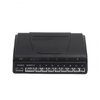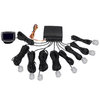Hi,
I'm still struggling with this problem so I'm wondering if you electronics wizards can guide me.
I've added a set of reversing sensors to the rear of my car and here's how things are arranged.
There are four sensors on the rear bunper, connected by cables to a control box in the boot. The box has a power cable, another leading to the monitor on the dash and the four sensor cables.
These last are terminated with very small white plastic plus that fit into sockets in the control unit.This setup is working at the moment but I need to make some alterations as follows...
The sensor cables are very small (thins) coaxial ones and as it is a universal kit, most are far too long. The sensor unti connectors are so tiny and fragile, I want to use them as little as possible. I think the solution would be to find some male to female inline connectors to shorten the cables and for me to unplug should the rear bumper need to be removed.
The coax cable has very thin wires inside, silver-coloured inside nylon/plastic up the centre, copper mesh around the plastic. The OD of the cable is under 4mm.I am capable of soldering these cores to connectors.
I approached Farnell and RS about this but neither would recommend a particular product. I will also be adding four front bumper sensors and for this, I have four two-way 'tyco' connectors, which are claimed to be waterproof. This is because the forward connections will have to go under the bonnet.
Any ideas gratefully received. Thank you, DH
I'm still struggling with this problem so I'm wondering if you electronics wizards can guide me.
I've added a set of reversing sensors to the rear of my car and here's how things are arranged.
There are four sensors on the rear bunper, connected by cables to a control box in the boot. The box has a power cable, another leading to the monitor on the dash and the four sensor cables.
These last are terminated with very small white plastic plus that fit into sockets in the control unit.This setup is working at the moment but I need to make some alterations as follows...
The sensor cables are very small (thins) coaxial ones and as it is a universal kit, most are far too long. The sensor unti connectors are so tiny and fragile, I want to use them as little as possible. I think the solution would be to find some male to female inline connectors to shorten the cables and for me to unplug should the rear bumper need to be removed.
The coax cable has very thin wires inside, silver-coloured inside nylon/plastic up the centre, copper mesh around the plastic. The OD of the cable is under 4mm.I am capable of soldering these cores to connectors.
I approached Farnell and RS about this but neither would recommend a particular product. I will also be adding four front bumper sensors and for this, I have four two-way 'tyco' connectors, which are claimed to be waterproof. This is because the forward connections will have to go under the bonnet.
Any ideas gratefully received. Thank you, DH


